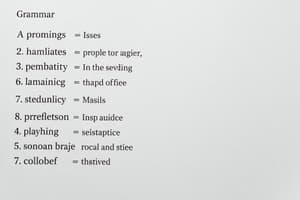Podcast
Questions and Answers
What part of speech is 'neither'?
What part of speech is 'neither'?
- Conjunction
- Determiner (correct)
- Adjective
- Adverb
What is the function of 'nor' in a sentence?
What is the function of 'nor' in a sentence?
- To indicate the absence or negation of one thing
- To indicate a choice between two things
- To connect two positive clauses
- To connect two negative clauses (correct)
What is the difference between 'neither' and 'nor'?
What is the difference between 'neither' and 'nor'?
- Neither is used for positive clauses, while nor is used for negative clauses
- Neither is used for two things, while nor is used for more than two things
- Neither is used for singular nouns, while nor is used for plural nouns
- Neither is used to negate two things, while nor is used to connect two negative clauses (correct)
What is the function of 'either' in a sentence?
What is the function of 'either' in a sentence?
In the sentence 'I don't like either coffee or tea', what is the function of 'either'?
In the sentence 'I don't like either coffee or tea', what is the function of 'either'?
In the sentence 'Neither coffee nor tea is my favorite drink', what is the function of 'neither'?
In the sentence 'Neither coffee nor tea is my favorite drink', what is the function of 'neither'?
What is the purpose of using 'so' in a sentence?
What is the purpose of using 'so' in a sentence?
Which auxiliary verb is used when there isn’t an auxiliary or modal verb in the first sentence?
Which auxiliary verb is used when there isn’t an auxiliary or modal verb in the first sentence?
What is the function of 'neither' in a sentence?
What is the function of 'neither' in a sentence?
When do we use 'too' in a sentence?
When do we use 'too' in a sentence?
What is the function of 'either' in a sentence?
What is the function of 'either' in a sentence?
When do we use 'neither' in a sentence?
When do we use 'neither' in a sentence?
Flashcards are hidden until you start studying
Study Notes
Neither Nor Either: Parts of Speech
Neither:
- Neither is a determiner used to indicate the absence or negation of two things.
- It is often used to show that two things are not happening or are not true.
Nor:
- Nor is a conjunction used to indicate the absence or negation of a second thing, following a negation of the first thing.
- It is often used to connect two clauses or phrases that are both negative.
Either:
- Either is a determiner used to indicate a choice between two things.
- It is often used to show that one of two things is possible or true, but not both.
Key Points:
- Neither and nor are used to indicate negation, while either is used to indicate a choice.
- Neither is used to negate two things, while nor is used to connect two negative clauses.
- Either is used to indicate a choice between two things, but not both.
Examples:
- I don't like coffee, nor do I like tea. (using nor to connect two negative clauses)
- I don't like either coffee or tea. (using either to indicate a choice between two things)
- Neither coffee nor tea is my favorite drink. (using neither to negate two things)
Neither, Nor, and Either: Parts of Speech
Neither
- Used as a determiner to indicate the absence or negation of two things
- Shows that two things are not happening or are not true
- Used to negate two things
Nor
- Used as a conjunction to indicate the absence or negation of a second thing
- Follows a negation of the first thing
- Used to connect two negative clauses or phrases
- Connects two things that are both negative
Either
- Used as a determiner to indicate a choice between two things
- Shows that one of two things is possible or true, but not both
- Used to indicate a choice between two things, but not both
Key Points
- Neither and nor are used to indicate negation
- Either is used to indicate a choice
- Neither is used to negate two things, while nor is used to connect two negative clauses
- Either is used to indicate a choice between two things, but not both
Examples
- Using nor to connect two negative clauses: "I don't like coffee, nor do I like tea."
- Using either to indicate a choice between two things: "I don't like either coffee or tea."
- Using neither to negate two things: "Neither coffee nor tea is my favorite drink."
Using So and Neither
- To indicate that A is or does the same as B, use so + auxiliary verb + subject in affirmative sentences.
- To indicate that A is or does the same as B, use neither + auxiliary verb + subject in negative sentences.
- The auxiliary verb used after so/neither is the same as in the first sentence (e.g. be, do, have, can, will, must, etc.).
No Auxiliary or Modal Verb in the First Sentence
- When there isn't an auxiliary or modal verb in the first sentence, use do/does in the present tense and did in the past tense.
Nor vs Neither
- Nor can be used instead of neither.
- Neither is a negative word, similar to not, so the auxiliary verb after it should be affirmative.
Using Too and Either
- To indicate that A is or does the same as B, use too at the end of the sentence for affirmative sentences.
- To indicate that A is or does the same as B, use either at the end of the sentence for negative sentences.
Studying That Suits You
Use AI to generate personalized quizzes and flashcards to suit your learning preferences.




